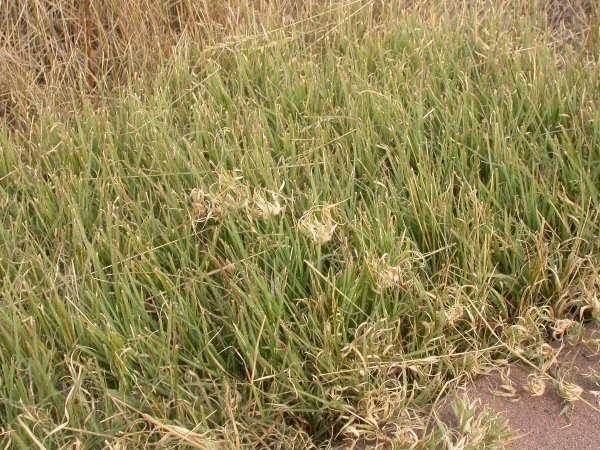
Buffalo Grass
Botanical Name
:
Bouteloua dactyloides
Plant Type
:
Warm-season perennial grass
Seasons
:
Active growth during late spring and summer; enters dormancy and turns brown in cooler temperature
Sun Level
:
6–8 hours of full sun daily (can tolerate partial shade but prefers full sun)
Ideal Soil Temperature for Planting
:
70–85°F (21–29°C)
Soil Type
:
Tolerant of most soil conditions, including clay and sandy soils but does particularly well in sandy soil
Hardiness Zones
:
Zones 3–9, it experiences extended dormancy periods due to cooler temperatures
Germination
:
7–21 days (from seed); sod or plugs establish faster
P.H. Level
:
6.5 to 7.5
Water/Irrigation
:
Low water needs; highly drought-tolerant once established (0.5–1 inch per week during active growth)
Fertilization
:
Low nitrogen requirements (1–2 lbs of nitrogen per 1,000 sq ft annually); apply in late spring or early summer
Habit
:
Forms a dense, low-growing turf; spreads via stolons, creating a sod-forming growth habit
Final Plant Height
:
Can reach 4 to 6 inches if left unmowed but should be maintained at 2 to 3 inches with mowing
Spread
:
Spreads through stolons, gradually covering the ground; establishment can be slow, often requiring two or more years for full coverage
Spacing
:
Plant plugs 6–12 inches apart for faster establishment; seed at 1–3 lbs per 1,000 sq ft.
Flowers
:
Produces inconspicuous seed heads that are generally not noticeable in well-maintained lawns
Attracts
:
Birds (seeds), beneficial insects (when allowed to flower) but re primarily used for turf applications
Uses
:
Low-maintenance lawns, golf course roughs, and erosion control due to its drought tolerance
Companions
:
Often grown alone but can be mixed with other drought-tolerant grasses like blue grama or sideoats grama
Pruning
:
Requires minimal mowing. Can be left unmowed for a natural look or mowed to maintain a uniform appearance at 2 to 3 inches
Toxicity
:
Non-toxic to humans and pets
Pests
:
Resistant to most pests, however, may occasionally encounter issues with chinch bugs or grubs
Diseases
:
Resistant to most diseases but can occasionally suffer from leaf spot or rust
Did You Know?
Early settlers used buffalo grass sod to build their homes, known as “sod houses” due to its dense, mat-forming growth?
Expert Care Tips
:
Due to its slow establishment and open growth habit, monitor for weed encroachment and manage as needed.
Botanical Name
:
Bouteloua dactyloides
Plant Type
:
Warm-season perennial grass
Seasons
:
Active growth during late spring and summer; enters dormancy and turns brown in cooler temperature
Sun Level
:
6–8 hours of full sun daily (can tolerate partial shade but prefers full sun)
Ideal Soil Temperature for Planting
:
70–85°F (21–29°C)
Soil Type
:
Tolerant of most soil conditions, including clay and sandy soils but does particularly well in sandy soil
Hardiness Zones
:
Zones 3–9, it experiences extended dormancy periods due to cooler temperatures
Germination
:
7–21 days (from seed); sod or plugs establish faster
P.H. Level
:
6.5 to 7.5
Water/Irrigation
:
Low water needs; highly drought-tolerant once established (0.5–1 inch per week during active growth)
Fertilization
:
Low nitrogen requirements (1–2 lbs of nitrogen per 1,000 sq ft annually); apply in late spring or early summer
Habit
:
Forms a dense, low-growing turf; spreads via stolons, creating a sod-forming growth habit
Final Plant Height
:
Can reach 4 to 6 inches if left unmowed but should be maintained at 2 to 3 inches with mowing
Spread
:
Spreads through stolons, gradually covering the ground; establishment can be slow, often requiring two or more years for full coverage
Spacing
:
Plant plugs 6–12 inches apart for faster establishment; seed at 1–3 lbs per 1,000 sq ft.
Flowers
:
Produces inconspicuous seed heads that are generally not noticeable in well-maintained lawns
Attracts
:
Birds (seeds), beneficial insects (when allowed to flower) but re primarily used for turf applications
Uses
:
Low-maintenance lawns, golf course roughs, and erosion control due to its drought tolerance
Companions
:
Often grown alone but can be mixed with other drought-tolerant grasses like blue grama or sideoats grama
Pruning
:
Requires minimal mowing. Can be left unmowed for a natural look or mowed to maintain a uniform appearance at 2 to 3 inches
Toxicity
:
Non-toxic to humans and pets
Pests
:
Resistant to most pests, however, may occasionally encounter issues with chinch bugs or grubs
Diseases
:
Resistant to most diseases but can occasionally suffer from leaf spot or rust
Did You Know?
Early settlers used buffalo grass sod to build their homes, known as “sod houses” due to its dense, mat-forming growth?
Expert Care Tips
:
Due to its slow establishment and open growth habit, monitor for weed encroachment and manage as needed.
Written by Salome Wapukha – https://www.linkedin.com/in/salome-wapukha-556700193/

